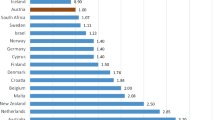Abstract
Mesothelioma with a pronounced myxoid stroma has been identified as a morphological pattern that might portend a better prognosis. Reports on this type of cases are few. Its clinical and pathological features are not defined. In this study, we identified 19 such cases from a series of 234 pleural mesotheliomas and performed a comprehensive clinical and pathological analysis. The inclusion criteria were mesotheliomas with at least 50% of the tumor exhibiting a pronounced myxoid stroma that occupied more than 50% of the tumor volume (designated as myxoid mesothelioma). There were ten males and nine females, with a median age of 58 years. Forty seven percent of the patients had probable or definite asbestos exposure. Patients presented at various stages [International Mesothelioma Interest Group (IMIG) stage II, 4; stage III, 9; and stage IV, 6]. Most (16/19) patients were treated by extrapleural pneumonectomy with adjuvant radiation or chemotherapy or both. Overall, the median survival rate was 36 months (median follow-up time, 17 months), and the 2-year survival rate was 79%. Histologically, the tumor cell component was entirely epithelioid without significant cytologic atypia. The myxoid material stained positive for Alcian blue, and the staining diminished after treatment with hyaluronidase in 12 of 12 cases. The tumor cells showed a typical mesothelial immunophenotype. Ultrastructurally, all six tumors examined had typical mesothelial-type surface microvilli and a moderately electron-dense extracellular amorphous material that often formed a haze enmeshing the surface microvilli. Hyaluronic acid-type, fern-like crystals were noted in all cases. These findings show that myxoid mesotheliomas represent a group of epithelioid mesotheliomas that have retained the secretory activity of normal mesothelium. Patients may present at different stages, but survival appears to be superior to that of epithelioid mesotheliomas in general. Our study emphasizes the need for better attention to histologic subtypes, particularly in the context of prognostically or therapeutically oriented investigations of this lethal disease.






Similar content being viewed by others
References
Baas P (2003) Predictive and prognostic factors in malignant pleural mesothelioma. Curr Opin Oncol 15:127–130
Butchart EG (1999) Contemporary management of malignant pleural mesothelioma. Oncologist 4:488–500
Butchart EG, Ashcroft T, Barnsley WC, Holden MP (1976) Pleuropneumonectomy in the management of diffuse malignant mesothelioma of the pleura. Experience with 29 patients. Thorax 31:15–24
Cook DS, Attanoos RL, Jalloh SS, Gibbs AR (2000) “Mucin-positive” epithelial mesothelioma of the peritoneum: an unusual diagnostic pitfall. Histopathology 37:33–36
Diaz LK, Okonkwo A, Solans EP, Bedrossian C, Rao MS (2002) Extensive myxoid change in well-differentiated papillary mesothelioma of the pelvic peritoneum. Ann Diagn Pathol 6:164–167
Goetz SP, Robinson RA, Landas SK (1992) Extraskeletal myxoid chondrosarcoma of the pleura. Report of a case clinically simulating mesothelioma. Am J Clin Pathol 97:498–502
Hammar SP, Bockus DE, Remington FL, Rohrbach KA (1996) Mucin-positive epithelial mesotheliomas: a histochemical, immunohistochemical, and ultrastructural comparison with mucin-producing pulmonary adenocarcinomas. Ultrastruct Pathol 20:293–325
Johansson L, Linden CJ (1996) Aspects of histopathologic subtype as a prognostic factor in 85 pleural mesotheliomas. Chest 109:109–114
Kaplan EL, Meier P (1958) Nonparametric estimation from incomplete observations. J Am Stat Assoc 53:457–481
Leonardo E, Zanconati F, Bonifacio D, Bonito LD (2001) Immunohistochemical MIB-1 and p27kip1 as prognostic factors in pleural mesothelioma. Pathol Res Pract 197:253–256
MacDougall DB, Wang SE, Zidar BL (1992) Mucin-positive epithelial mesothelioma. Arch Pathol Lab Med 116:874–880
Marcus PB (1981) Glycocalyceal bodies and their role in tumor typing. J Submicrosc Cytol 13:483–500
Mark EJ, Shin DH (1993) Diffuse malignant mesothelioma of the pleura: a clinicopathological study of six patients with a prolonged symptom-free interval or extended survival after biopsy and a review of the literature of long-term survival. Virchows Arch, A Pathol Anat Histopathol 422:445–451
Robb JA (1989) Mesothelioma versus adenocarcinoma: false-positive CEA and Leu-M1 staining due to hyaluronic acid. Hum Pathol 20:400
Rusch VW (1996) A proposed new international TNM staging system for malignant pleural mesothelioma from the International Mesothelioma Interest Group. Lung Cancer 14:1–12
Rusch VW, Rosenzweig K, Venkatraman E, Leon L, Raben A, Harrison L, Bains MS, Downey RJ, Ginsberg RJ (2001) A phase II trial of surgical resection and adjuvant high-dose hemithoracic radiation for malignant pleural mesothelioma. J Thorac Cardiovasc Surg 122:788–795
Rusch VW, Venkatraman E (1996) The importance of surgical staging in the treatment of malignant pleural mesothelioma. J Thorac Cardiovasc Surg 111:815–825 (discussion 825–826)
Rusch VW, Venkatraman ES (1999) Important prognostic factors in patients with malignant pleural mesothelioma, managed surgically. Ann Thorac Surg 68:1799–1804
Shia J, Erlandson RA, Klimstra DS (2002) Deciduoid mesothelioma: a report of 5 cases and literature review. Ultrastruct Pathol 26:355–363
Yao DX, Shia J, Erlandson RA, Klimstra DS (2004) Lymphohistiocytoid mesothelioma: a clinical, immunohistochemical and ultrastructural study of four cases and literature review. Ultrastruct Pathol 28:213–228
Yates DH, Corrin B, Stidolph PN, Browne K (1997) Malignant mesothelioma in south east England: clinicopathological experience of 272 cases. Thorax 52:507–512
Acknowledgements
The authors thank Ms. Irina Linkov and Ms. Marina Asherova of the Immunohistochemistry Core Facility, Ms. Ann Baren and Ms. Elizabeth Weiss of the Electron Microscopy Laboratory, and Mr. Kin C. Kong and Ms. Allyne Manzo of the Photography Laboratory at Memorial Sloan-Kettering Cancer Center for their technical support.
Author information
Authors and Affiliations
Corresponding author
Rights and permissions
About this article
Cite this article
Shia, J., Qin, J., Erlandson, R.A. et al. Malignant mesothelioma with a pronounced myxoid stroma: a clinical and pathological evaluation of 19 cases. Virchows Arch 447, 828–834 (2005). https://doi.org/10.1007/s00428-005-0035-y
Received:
Accepted:
Published:
Issue Date:
DOI: https://doi.org/10.1007/s00428-005-0035-y




